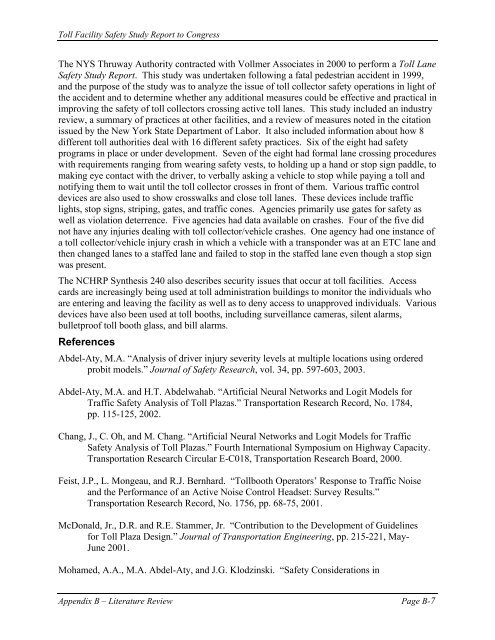Toll Facility Safety Study Report to Congress - About
Toll Facility Safety Study Report to Congress - About
Toll Facility Safety Study Report to Congress - About
Create successful ePaper yourself
Turn your PDF publications into a flip-book with our unique Google optimized e-Paper software.
<strong>Toll</strong> <strong>Facility</strong> <strong>Safety</strong> <strong>Study</strong> <strong>Report</strong> <strong>to</strong> <strong>Congress</strong><br />
The NYS Thruway Authority contracted with Vollmer Associates in 2000 <strong>to</strong> perform a <strong>Toll</strong> Lane<br />
<strong>Safety</strong> <strong>Study</strong> <strong>Report</strong>. This study was undertaken following a fatal pedestrian accident in 1999,<br />
and the purpose of the study was <strong>to</strong> analyze the issue of <strong>to</strong>ll collec<strong>to</strong>r safety operations in light of<br />
the accident and <strong>to</strong> determine whether any additional measures could be effective and practical in<br />
improving the safety of <strong>to</strong>ll collec<strong>to</strong>rs crossing active <strong>to</strong>ll lanes. This study included an industry<br />
review, a summary of practices at other facilities, and a review of measures noted in the citation<br />
issued by the New York State Department of Labor. It also included information about how 8<br />
different <strong>to</strong>ll authorities deal with 16 different safety practices. Six of the eight had safety<br />
programs in place or under development. Seven of the eight had formal lane crossing procedures<br />
with requirements ranging from wearing safety vests, <strong>to</strong> holding up a hand or s<strong>to</strong>p sign paddle, <strong>to</strong><br />
making eye contact with the driver, <strong>to</strong> verbally asking a vehicle <strong>to</strong> s<strong>to</strong>p while paying a <strong>to</strong>ll and<br />
notifying them <strong>to</strong> wait until the <strong>to</strong>ll collec<strong>to</strong>r crosses in front of them. Various traffic control<br />
devices are also used <strong>to</strong> show crosswalks and close <strong>to</strong>ll lanes. These devices include traffic<br />
lights, s<strong>to</strong>p signs, striping, gates, and traffic cones. Agencies primarily use gates for safety as<br />
well as violation deterrence. Five agencies had data available on crashes. Four of the five did<br />
not have any injuries dealing with <strong>to</strong>ll collec<strong>to</strong>r/vehicle crashes. One agency had one instance of<br />
a <strong>to</strong>ll collec<strong>to</strong>r/vehicle injury crash in which a vehicle with a transponder was at an ETC lane and<br />
then changed lanes <strong>to</strong> a staffed lane and failed <strong>to</strong> s<strong>to</strong>p in the staffed lane even though a s<strong>to</strong>p sign<br />
was present.<br />
The NCHRP Synthesis 240 also describes security issues that occur at <strong>to</strong>ll facilities. Access<br />
cards are increasingly being used at <strong>to</strong>ll administration buildings <strong>to</strong> moni<strong>to</strong>r the individuals who<br />
are entering and leaving the facility as well as <strong>to</strong> deny access <strong>to</strong> unapproved individuals. Various<br />
devices have also been used at <strong>to</strong>ll booths, including surveillance cameras, silent alarms,<br />
bulletproof <strong>to</strong>ll booth glass, and bill alarms.<br />
References<br />
Abdel-Aty, M.A. “Analysis of driver injury severity levels at multiple locations using ordered<br />
probit models.” Journal of <strong>Safety</strong> Research, vol. 34, pp. 597-603, 2003.<br />
Abdel-Aty, M.A. and H.T. Abdelwahab. “Artificial Neural Networks and Logit Models for<br />
Traffic <strong>Safety</strong> Analysis of <strong>Toll</strong> Plazas.” Transportation Research Record, No. 1784,<br />
pp. 115-125, 2002.<br />
Chang, J., C. Oh, and M. Chang. “Artificial Neural Networks and Logit Models for Traffic<br />
<strong>Safety</strong> Analysis of <strong>Toll</strong> Plazas.” Fourth International Symposium on Highway Capacity.<br />
Transportation Research Circular E-C018, Transportation Research Board, 2000.<br />
Feist, J.P., L. Mongeau, and R.J. Bernhard. “<strong>Toll</strong>booth Opera<strong>to</strong>rs’ Response <strong>to</strong> Traffic Noise<br />
and the Performance of an Active Noise Control Headset: Survey Results.”<br />
Transportation Research Record, No. 1756, pp. 68-75, 2001.<br />
McDonald, Jr., D.R. and R.E. Stammer, Jr. “Contribution <strong>to</strong> the Development of Guidelines<br />
for <strong>Toll</strong> Plaza Design.” Journal of Transportation Engineering, pp. 215-221, May-<br />
June 2001.<br />
Mohamed, A.A., M.A. Abdel-Aty, and J.G. Klodzinski. “<strong>Safety</strong> Considerations in<br />
Appendix B – Literature Review Page B-7

















